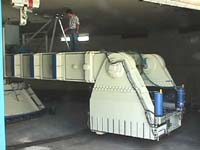Project Summary

Nonlinear site response methods are theoretically superior to equivalent linear methods when shear strains become large.
Previous studies have evaluated various nonlinear site response
codes, and provided recommendations on their implementation (http://escholarship.org/uc/item/7db3d49z). However, only a very limited number of field downhole arrays have recorded strong enough shaking to validate nonlinear site
response methods at large strains, where they presumably provide the most benefit. The purpose of this centrifuge test sequence
is to construct two models of soft clay with different layering
and overconsolidation profiles, and use embedded accelerometer arrays to observe the response under strong ground shaking.
The models were constructed in the new hinged-plate container, which offers significant benefits for site response problems
since the lateral response of the container is so flexible,  and closely represents 1-D site response shaking conditions.
Many previous centrifuge studies of site response have utilized
shear beam containers that can exhibit undesired and influential stiffness effects on very soft models. A goal of this experimental
study is to evaluate the ability of the new container to represent 1-D site response boundary conditions.
and closely represents 1-D site response shaking conditions.
Many previous centrifuge studies of site response have utilized
shear beam containers that can exhibit undesired and influential stiffness effects on very soft models. A goal of this experimental
study is to evaluate the ability of the new container to represent 1-D site response boundary conditions.
The models were constructed from San Francisco bay mud, which was mixed as a slurry, poured into the model container, and pre-consolildated in thin lifts using a hydraulic press prior to testing on the centrifuge. Significant advances have been made during this test regarding the approach to effectively consolidating the bay mud on the press. We found that placing a thick layer of sand on top of the slurry sealed the clay in, permitting application of large vertical stress to the slurry without squeezing clay out of the model. Previously, only very small initial total stress increments could be imposed on the slurry before it began oozing out around the hydraulic press plate. After consolidation the models were placed on the centrifuge and spun to 60g to represent a deep prototype deposit. A 0.5m thick model behaves as a 30m thick prototype soil deposit at 60g. A sequence of motions was imposed on the models, starting with very low-level ground motions to assess the small-strain elastic properties of the models, followed by medium ground motions, and finally large ground motions intended to mobilize significant shear strain in the soft clay. All ground motions were realistic broad-band motions that were scaled versions of real recorded motions. All test data from the centrifuge test program will be archived and curated on the neesCentral data repository since this project has a NEES "shared-use" designation.

